Customer Success vs Customer Experience: What You Should Know

On this page:
- What is Customer Success?
- What is Customer Experience?
- Customer Success vs Customer Experience
- Roles of CS and CX Managers
- Metrics for CS and CX
- How CS and CX Work Together
- Strategies for Enhancing CS and CX
- Build a Customer-Centric Approach
- Challenges and Solutions
- Key Points to Note
- Customer Success vs Customer Experience: Frequently Asked Questions
What is Customer Success?
Customer success is a proactive approach focused on helping customers achieve their desired outcomes while maximizing value from your products or services.
Unlike customer service, which often reacts to issues post-occurrence, customer success takes preemptive steps to ensure customers meet their goals effectively.
This strategy is a no-brainer in B2B industries such as SaaS. Holding on to those customers through renewals and repeat purchases powers long-term, healthy growth.
By empathizing with customer goals and strategically connecting them with the value found in your products, you set the stage for successful outcomes now and into the future.
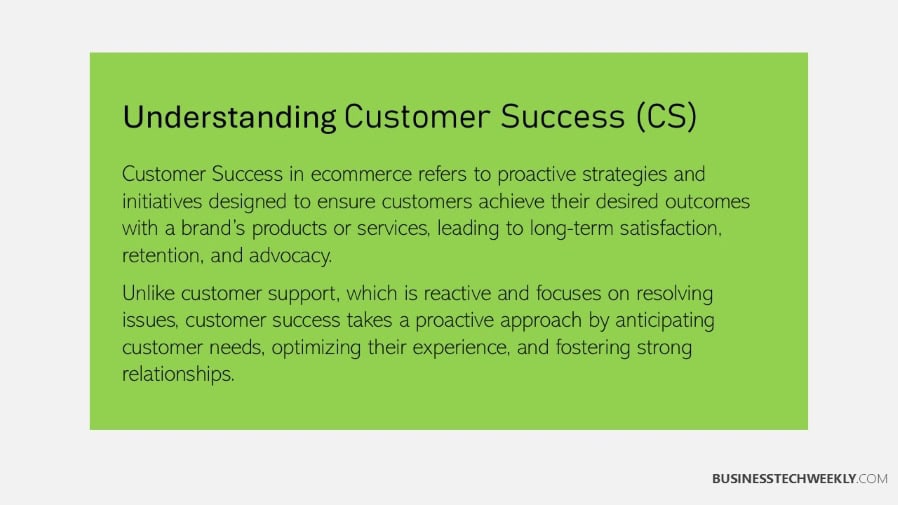
Key Objectives of Customer Success
Understanding the dynamics of Customer Success vs Customer Experience helps businesses ensure they deliver both proactive solutions and meaningful interactions that foster loyalty.
Customer success aims to achieve several goals that directly impact your business performance. Delivering value consistently builds trust and ensures positive interactions.
Proactively addressing needs reduces churn, a major concern for subscription-based businesses.
Active users are more likely to adopt your offerings fully, leading to better results. Satisfied customers often become brand ambassadors, sharing testimonials and generating referrals.
Upselling and cross-selling play important roles too.
When implemented strategically, these tactics boost overall revenue and demonstrate the value of other available offerings that are better suited to customers’ objectives.
While Customer Success vs Customer Experience are often interlinked, they serve distinct functions that together enhance business growth and customer loyalty.
It’s all about building those lasting relationships, because that’s what drives truly sustainable business success.
Main Components of Customer Success
Analyzing the key differences in Customer Success vs Customer Experience can provide valuable insights into how businesses maintain consistent engagement while shaping customer perceptions.
Effective customer success strategies include several essential elements. Identifying critical stages in the customer journey helps maintain consistent engagement.
Offering guidance before issues arise ensures smoother experiences.
Providing training and resources empowers customers to use your products effectively.
Monitoring feedback, adoption rates, and other indicators drives informed improvements.
Building relationships is essential to establishing trust.
By analyzing CX data, your team can pinpoint opportunities for continuous improvement, ensuring that customers consistently benefit from your solutions.
Importance of Customer Success
It’s not just beneficial. Proactively meeting customer needs fosters long-lasting retention relationships while reducing costly acquisition efforts.
Retention of your current customers is 5 times more cost-efficient than acquiring new customers.
Delight loyal, happy customers. Happy customers further your growth through referral business, positive testimonials, and by expanding their use of your product.
The more you aid your customers in those accomplishments, the more you increase customer happiness.
This happiness breeds loyalty and paves the way for improved renewal rates and increased scale of business.
What is Customer Experience?
It’s no exaggeration that customer experience ultimately determines how customers feel about your brand.
It accumulates through each interaction they have with you along their journey. It’s not only about the products and services you provide either.
Beyond convenience, today it’s about how customers feel, what they think, and how they view your brand at each point of interaction.
From the initial contact to post-purchase support, these interactions shape their opinions and emotions, influencing whether they remain loyal or look elsewhere.
When done right, a memorable customer experience builds trust and credibility that can lead to lifelong customers.
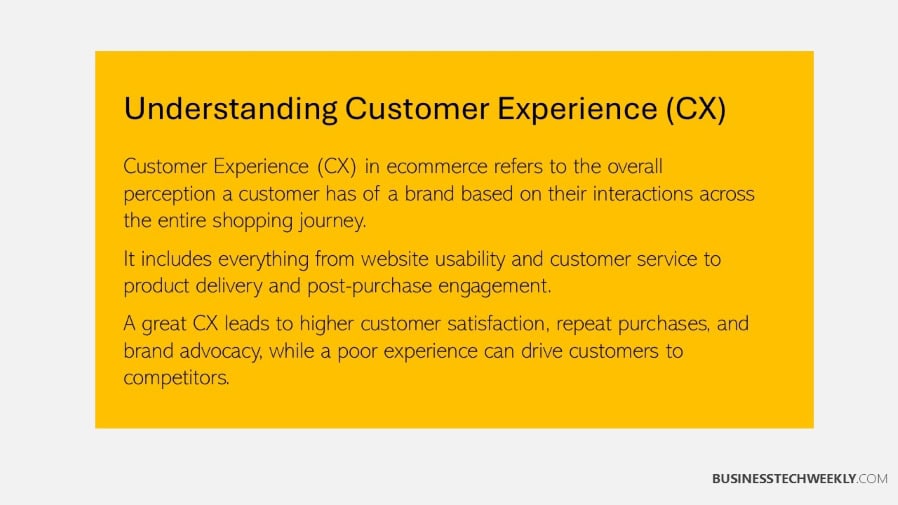
Key Objectives of Customer Experience
- Achieve high customer satisfaction by meeting and exceeding expectations.
- Help your brand stand out in crowded marketplaces by providing exceptional experiences.
- Enhance customer lifetime value through consistent, positive interactions.
Delightful interactions are essential to building those warm, fuzzy connections.
For instance, Amazon Prime, adopted by 82% of U.S. Subscribers, exemplifies how premium features like fast delivery and exclusive content meet customer needs while exceeding expectations.
Orchestrating these experiences create more repeat business and more powerful, organic word-of-mouth referrals, bringing customers back and keeping them more loyal.
Main Components of Customer Experience
- Applying your brand consistently to every touchpoint creates a unique state of quality, providing a sense of value at all stages of the experience.
- Customer Success vs Customer Experience both benefit from personalization, but while success focuses on driving measurable outcomes, experience enhances emotional connections.
- Personalization tailors communication and services to individual preferences, such as an e-commerce platform recommending relevant products based on browsing history.
- Whether it’s through the checkout experience, managing an account, whatever it might be—reduces that friction.
While speed is important, empathy is just as critical.
Whether it’s a quick answer to questions or anticipation of a customer’s specific needs, these factors create confidence.
We’ve all seen how successful seamless omnichannel strategies, such as making it easy to return online purchases in-store, provide cohesive experiences.
Personalized outreach and engagement only deepens connections and creates an inclusive culture where every customer feels valued and recognized.
Importance of Customer Experience
Never forget the difference one thread of extraordinary customer experience can make.
These emotional connections create brand loyalty, so happy customers are more likely to remain customers and promote your company.
That’s why, for instance, capitalizing on post-purchase feedback goes a long way to fine-tune future interactions and boost retention.
By aligning Customer Success vs Customer Experience strategies, businesses can simultaneously drive retention and optimize every customer touchpoint.
These intentional efforts deepen personal relationships and have the powerful secondary benefit of accelerating revenue growth.
They show that customer experience is an invaluable long-term driver of success.
A Bain & Company survey revealed that while 80% of businesses believe they deliver superior customer experiences, only 8% of customers agree.
Customer Success vs Customer Experience
Understanding the distinction between customer success and customer experience is essential for businesses aiming to build a comprehensive customer strategy.
Though both ideas are centered around fostering and improving customer relationships, they approach their aims from different angles.
Customer success is about creating measurable wins that make their lives better.
In contrast, customer experience focuses on creating those emotional connections and influencing perceptions at every stage of the customer journey.
Combined, these three facets form a comprehensive experience-led strategy that ignites loyalty, encourages satisfaction, and fosters long-term success.
1. Define Customer Success
Customer success is driving customers to the outcomes they want through proactive, prescriptive, and preventative guidance and support.
It’s all about ensuring they’re getting the most value out of your products or services.
Customer success managers (CSMs) are fundamental to this process.
They serve as your strategic partners, helping you to drive customer success and align customer goals with your business goals.
For instance, in a SaaS business, a CSM might guide a customer through product adoption, ensuring they use key features effectively.
This alignment between the experience delivered and customer expectation not only enhances customer loyalty, but leads to greater long-term success.
Research shows that only 38% of brands globally employ structured customer success solutions, leaving significant room for businesses to stand out by investing in this area.
2. Define Customer Experience
Customer experience involves all interactions a customer has with your brand, including when they’re exploring your website or post-purchase assistance.
It’s a true representation of how customers experience the entire journey, creating positive or negative perceptions about your business.
Metrics like Net Promoter Score (NPS) or CSAT satisfaction scores typically evaluate this.
For instance, having a smooth, easy-to-use checkout process in an online shopping store can have a long-term, positive impact.
Understanding how to manage these touchpoints to provide a seamless experience builds loyalty and turns customers into advocates for your brand.
With 51% of organizations now employing customer experience specific teams, getting this aspect right is more important than ever competitively.
3. Primary Goals Compared
|
Aspect |
Customer Success |
Customer Experience |
|---|---|---|
|
Focus |
Measurable outcomes |
Emotional satisfaction |
|
Approach |
Proactive |
Reactive |
|
Metrics |
Adoption rates, retention |
NPS, satisfaction scores |
|
Objective |
Achieve customer goals |
Enhance perceptions across touchpoints |
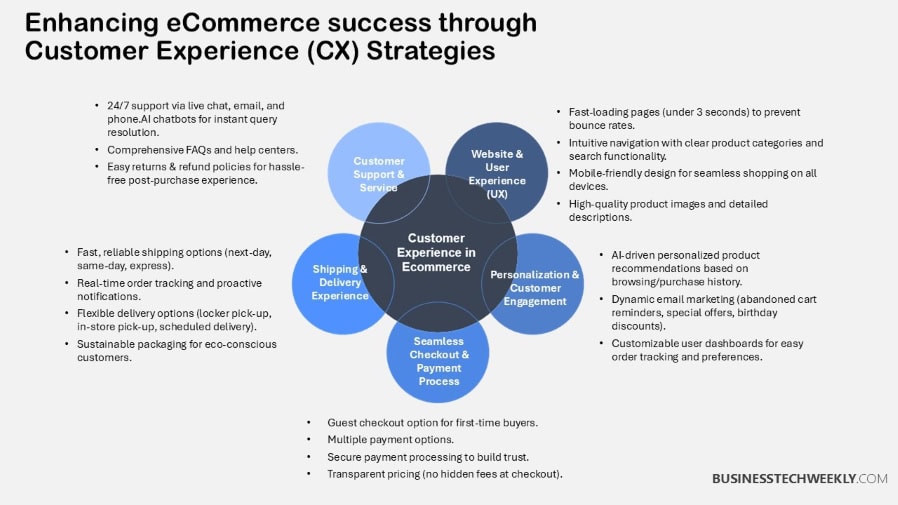
Roles of CS and CX Managers
Customer success (CS) and customer experience (CX) managers are key roles in building relationships with your customers.
They continually create and develop these connections to drive enduring devotion.
This distinction between Customer Success vs Customer Experience highlights how companies must balance proactive strategies with reactive engagement for a comprehensive approach.
Even though their responsibilities and tasks intersect in several areas, each role brings something different to the table that advances your business objectives.
Clarity on these differences will help your teams align to create a customer experience that builds satisfaction and loyalty.
Customer Success Manager Duties
Customer success managers use a proactive, customer-centric approach to help customers reach their goals and grow along the way.
Key duties include:
- Guiding new customers through the onboarding process and ensuring they understand how to use your product effectively.
- Helping customers maximize value by adopting product features that meet their needs. To achieve this, CS teams will implement tools such as Gainsight CS to deliver customized, strategic approaches.
- Tracking metrics like customer health scores and gathering feedback at critical touchpoints to anticipate potential challenges.
- Identifying moments to introduce additional products or services, aligned with customer goals.
CS managers are customer advocates and can work with CX and product teams to help develop actionable feedback. Coordinated through regular surveys, playbooks, and targeted problem resolutions, they keep your customers happy and connected.
Customer Experience Manager Duties
Customer experience managers are in charge of the overall experience that your customers have in joining your brand’s journey.
Their responsibilities include:
- Ensuring every interaction—from website navigation to support channels—delivers a seamless experience.
- Using tools and data to identify trends, improve processes, and address pain points. In fact, 46% of customers want to see a response to negative reviews, proving that fast action is of the utmost importance.
- Creating tailored experiences that resonate with diverse customer needs, fostering long-term loyalty.
- Maintaining a unified voice and visual identity across all customer interactions.
CX teams start with holistic strategies before diving into tactical steps, ensuring that every action aligns with your brand’s vision.
Skills for Both Roles
Both roles require:
- Strong communication and empathy to connect with customers.
- Analytical skills for data-driven decision-making.
- Problem-solving abilities to address challenges effectively.
- Cooperation to harmonize with cross-functional teams and unified objectives.
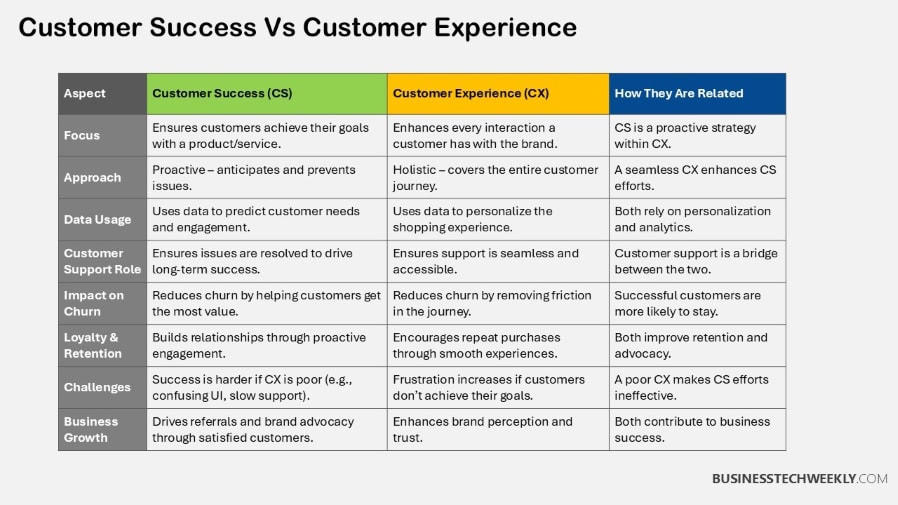
Metrics for CS and CX
Metrics play a vital role in measuring the success of customer-focused strategies.
Understanding Customer Success vs Customer Experience metrics allows businesses to measure both the tangible impact of success initiatives and the emotional responses driven by experience strategies.
For customer success (CS), metrics are essential to recognizing patterns that drive both retention revenue and positive customer health.
For customer experience (CX), they show how well a company is doing at meeting customer expectations across the entire customer journey.
When you focus on the right metrics, you position yourself to make smarter decisions, refine your strategies over time, and build deeper relationships with your customers.
Customer Success Metrics Examples
The best customer success metrics tell you how to improve customers’ health and accelerate your business’ growth.
Key metrics include:
- Churn Rate: Helps assess the percentage of customers leaving over a specific period.
- Tracks how well you’re keeping customers engaged and loyal.
- Provides a holistic, 360-degree view of customer happiness, product adoption, and overall business engagement.
- Upsell and Cross-Sell Success Rates: Measures the effectiveness of expanding your offerings to existing customers.
By tracking and measuring these metrics, you can catch at-risk customers before they churn by customizing your outreach to boost customer satisfaction.
When the churn rate suddenly increases, CS teams go on the defensive.
They work alongside CX and product teams to address customer pain points and improve adoption rates.
Ongoing customer feedback further informs strategy, keeping you focused on the biggest drivers to deliver what they want and need most.
Customer Experience Metrics Examples
Customer experience (CX) metrics aim to measure satisfaction and even the ease of interaction.
Notable examples include:
- Measures how satisfied customers are with a specific interaction.
- Net Promoter Score (NPS): Gauges customer loyalty and likelihood to recommend your brand.
- Customer Effort Score (CES): Evaluates how easy it is for customers to complete a task, such as resolving an issue.
Combined, these metrics offer a complete picture of customer sentiment.
For instance, low NPS scores may indicate gaps in service, prompting CX teams to streamline processes and enhance the overall experience.
Ongoing evaluation helps make sure that your CS initiatives don’t get stagnant or out of touch.
How Metrics Inform Strategy
Metrics should inform every strategic decision made on behalf of CS and CX.
By analyzing data, you can align goals with customer expectations, identify improvement areas, and enhance collaboration across teams.
For ongoing improvement, leverage metrics in the following ways:
- Adjust onboarding to boost adoption and health scores.
- Use customer feedback to refine product features and processes.
- Track trends to predict what customers will want and get the most value out of retention strategies.
Companies that focus on enhancing customer experience can see an 80% increase in revenue.
How CS and CX Work Together
Customer Success (CS) and Customer Experience (CX) go hand in hand.
Working in unison, they create a fluid and fulfilling experience for your customers.
CX focuses on the overall experience customers have with your brand.
CS is all about guiding those customers to the outcomes they want to realize with your product or service.
When combined, they create a potent duo that not only significantly improves customer satisfaction, but fosters business growth over time.
These teams work together to share insights and align strategies. In doing so, they focus on customer needs end-to-end, creating an experience from onboarding through product adoption and retention.
Enhance Customer Onboarding
Onboarding done right lays the groundwork for an enduring, mutually beneficial relationship.
As with so many things, a tailored approach, one that gets the nuance of individual customer goals, can be the difference.
Simple, proactive communication, easy-to-follow instructions, and readily available support go a long way in establishing comfort levels and smoothing the transition.
For example, an e-commerce platform might offer personalized tutorials tailored to a customer’s business size or sector.
This method ensures that the tutorials are practical and provide instant value.
Best Practices for Onboarding:
- Develop personalized walkthroughs and tutorials.
- Maintain consistent communication through email or in-app messaging.
- Make resources easy to find, such as FAQ sections and live chat functionality.
- Regularly check in to address questions or concerns.
Drive Product Adoption
Driving product adoption is all about helping customers realize the value of fully leveraging your products and services.
User education via webinars, online and in-person guides, and hands-on training makes sure your customers know how to get the most value from your product.
Feedback loops are just as important.
Tactics for Product Engagement:
- Host regular training sessions and Q&A webinars.
- Offer feature-specific tutorials and knowledge base articles.
- Use customer feedback to refine and enhance product usability.
Improve Customer Retention
Retention is absolutely essential to achieving durable, sustainable growth.
Customer service leaders proactively engage to identify at-risk customers, while customer experience professionals build strong relationships that create loyalty.
For example, a SaaS company might use usage analytics to offer timely support or suggest upgrades that align with a customer’s evolving needs.
Retention Strategies:
- Analyze customer behavior to predict potential churn.
- Conduct periodic check-ins to address challenges early.
- Offer loyalty rewards or exclusive access to new features.
Support Account Expansion
Account expansion is most effective when you know what your customer is trying to accomplish.
CS teams are in the best position to recognize upselling opportunities through usage pattern analysis or conversations about future needs during quarterly check-ins.
A cloud-based software firm, for example, could recommend more robust tools after a customer’s needs have exceeded the plan under which they’ve been using the solution.
Expansion Tactics:
- Propose upgrades or new features aligned with customer objectives.
- Share case studies showcasing successful upselling stories.
- Build trust through consistent, value-driven communication.
Foster Customer Loyalty
Loyal customers lead to further repeat business and referrals. Trust and emotional connection come from impactful experiences and continuous engagement.
For instance, a digital marketing agency that is skilled at delivering a steady stream of measurable results will create organic loyalty.
Loyalty Strategies:
- Prioritize personalized support and timely problem resolution.
- Celebrate customer milestones or achievements.
- Encourage feedback and implement suggestions to show you’re listening
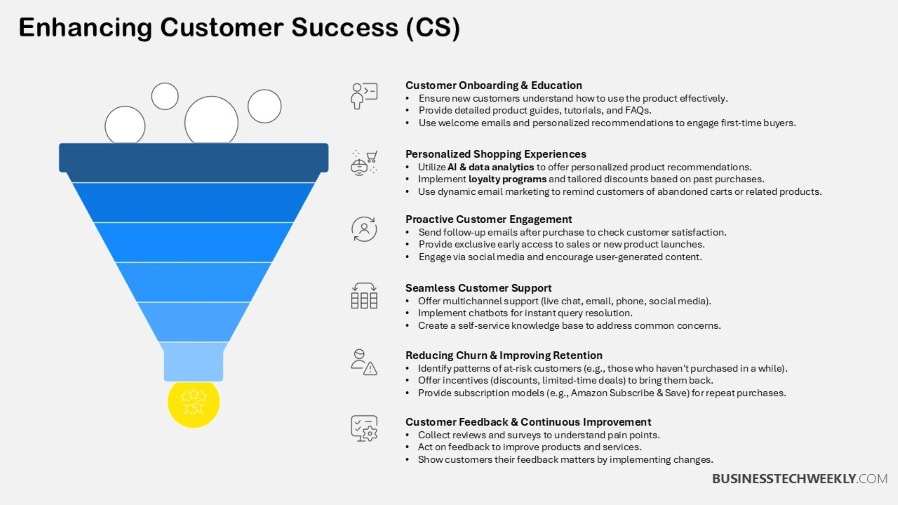
Strategies for Enhancing CS and CX
Striking a healthy balance between customer success (CS) and customer experience (CX) is imperative to accelerating growth and building loyalty.
Where CS has a critical role in helping customers reach their objectives, CX emphasizes shaping new, easy, convenient customer experiences.
Together, they reinforce each other to create a powerful foundation for long-term business success.
Here are several actionable strategies to improve each area, and do so in tandem to maximize impact.
Gather Customer Feedback
It all starts with putting on your listening ears, and figuring out what they want and expect.
Customer feedback is the best way to identify pain points and opportunities to improve both CS and CX. Tools like surveys, interviews, and feedback forms give you absolute clarity on how customers feel.
A simple post-purchase survey can help you identify issues with your checkout process.
Ethnographic studies or other long-term customer interviews can reveal pathways to more meaningful relationships.
Best Practices for Collecting Feedback:
- Use short, targeted surveys to respect customers’ time.
- Offer incentives, like discounts, to increase participation.
- Roll out real-time feedback experiences on your website or mobile app.
- Regularly analyze feedback trends to prioritize improvements.
Personalize Customer Interactions
Hyper-personalization goes beyond just marketing; it is crucial for developing valuable customer connections.
Personalizing every interaction through customer data—like previous purchase behavior or the current note in your contact center’s virtual agent—ensures your communications are relevant and drive appropriate actions.
Making intelligent recommendations—like suggesting complementary products based on previous purchases—makes customers happier and leads to more sales.
Effective Personalization Tactics:
- Use CRM tools like Nextiva to track preferences.
- Segment customers for targeted marketing campaigns.
- Send personalized emails with product recommendations.
- Offer loyalty rewards tailored to individual spending patterns.
Use Data Analytics Effectively
Data analytics lets you uncover and act on valuable data to improve CS and CX.
Through behavioral analysis, you’ll be able to spot trends, anticipate what customers will need in the future, and solve problems before they even occur.
Customer Success vs Customer Experience leverage different metrics, but when analyzed together, they provide a complete picture of customer engagement and brand loyalty.
For instance, tracking distance NPS scores is a great way to gauge customer satisfaction and loyalty.
Key Tools and Techniques:
- Leverage AI tools for predictive analytics.
- Monitor customer activity to identify churn risks.
- Use dashboards to visualize customer journey metrics.
- Continuously refine strategies based on analyzed data.
Train Employees on Customer-Centricity
Your team is your most important asset when it comes to creating amazing, engaging experiences for customers.
Cultural initiatives Training programs on customer-centricity are an important step in making sure all employees know how their actions affect customer satisfaction and company success.
Personal onboarding assistance like a kickoff call or product walkthrough can help enhance the experience even more.
Training Focus Areas:
- Active listening and effective communication skills.
- Problem-solving techniques for customer support.
- Aligning actions with company CX goals.
- Cultural sensitivity for global customer bases.
Streamline Communication
Concise, purposeful communication is key to effective CS and CX.
Providing fast resolutions through the most effective channels like live chat with AI-powered chatbots makes every customer interaction count and makes them feel appreciated.
By ensuring you proactively communicate at every touchpoint, trust is built and friction is lessened.
Best Practices for Communication:
- Use omnichannel platforms to centralize communication.
- Automate responses for common queries with chatbots.
- Set realistic response time expectations for customers.
- Make it easy to get help. Add new FAQs and help centers upon frequent self-service inquiries.
Proactive customer success strategies can lead to a 5% increase in customer retention rates, which can boost profits by up to 95%.
Build a Customer-Centric Approach
A truly customer-centric approach, embedded in all aspects of business operations, is key to building loyalty, creating new forms of growth, and achieving sustainable success in the future.
By prioritizing both customer success (CS) and customer experience (CX), businesses can create meaningful interactions that resonate with their audience.
This strategy does more than just improve satisfaction; it fosters trust and confidence leading to increased lifetime value and repeat business.
Companies that integrate CS and CX effectively are better positioned to meet evolving customer expectations and maintain relevance in competitive markets.
Align Teams and Goals
Aligning customer success and experience teams horizontally across an organization is critical to delivering holistic and seamless support.
When marketing and product development are both focused on shared objectives, companies can develop a more cohesive approach to meet customer needs in an integrated way.
Improved communication among touch points, less duplication of effort, and more impact on need help foster a more coherent experience.
Establishing things like joint customer journey maps can identify areas where both marketing and service teams play a role in shaping the overall customer experience.
Shared metrics, such as Net Promoter Score (NPS) or customer satisfaction scores (CSAT), further enhance teamwork by providing measurable objectives.
Strategies for alignment:
- Establish distinct responsibilities for CS and CX to prevent overlap and confusion.
- Align on common customer lifetime value and customer satisfaction goals.
- Deliver with rapidly updated, collaborative tools that improve communication and break down silos.
- Schedule regular cross-team working meetings to track progress and iterate on strategies.
Prioritize Customer Needs
Each decision needs to demonstrate a clear intent to improve customer experience.
When you listen to customer feedback via surveys, reviews, or conversations, you can create products and services that better serve your intended audience.
For example, analysis of customer complaints should inform product development or service improvement efforts.
Ongoing engagement keeps your company dialed into what’s important as customer preferences change, creating loyalty and advocacy.
Tactics to prioritize needs:
- Actively gather feedback at key touchpoints.
- Develop a process for analyzing and addressing customer feedback.
- Personalize interactions based on customer preferences.
- Regularly update offerings to address evolving demands.
Measure and Improve Continuously
Constant measurement will be key in improving customer-first efforts. Metrics such as NPS, CSAT, and Digital Experience Scores (DXS) deliver the kind of actionable data necessary for understanding the customer journey.
Consistent progress monitoring allows for early course corrections and flexibility to pivot strategies.
For instance, a downtrend in DXS could indicate that better digital touchpoints are needed.
Key performance indicators to track:
- Monitor customer retention rates and repeat purchases.
- Analyze NPS for insights into brand advocacy.
- Measure CSAT to evaluate satisfaction at individual touchpoints.
- Track resolution times to identify bottlenecks in support processes.
Challenges and Solutions
The intersection of customer success (CS) and customer experience (CX) presents opportunities for businesses to grow, but it brings unique challenges.
Aligning these strategies demands several things including breaking down internal silos, creating shared customer-focused goals and objectives, and identifying methods to measure the often intangible customer interactions.
Fixing these problems opens the door to significant long-term value for your enterprise.
Aligning CS and CX Strategies
Aligning customer success and customer experience strategies is a critical step in ensuring a cohesive journey for today’s modern customers.
When these two functions are aligned, they can combine to create higher retention, better satisfaction and greater lifetime value.
Yet without any common direction, initiatives and campaigns individually fizzle out into fragmented, piecemeal action.
For example, where CX teams often look to build emotional connections with users, CS teams are more concerned with achieving certain known outcomes such as health scores or renewals.
This gap is often a major obstacle to moving forward.
Bridged collaboration begins with common metrics that focus on customer satisfaction and task success.
For instance, using Net Promoter Scores (NPS) in conjunction with renewal rates gives a more complete customer loyalty picture. Communication is just as important.
Holding consistent cross-departmental meetings encourage an understanding and alignment of each other’s goals.
Strategies to align CS and CX efforts include:
- Developing unified customer journey maps to identify overlapping objectives.
- Enabling shared dashboards across departments for greater visibility into performance metrics in real-time.
- Holding joint customer-service training sessions, to help each group develop a shared understanding of the other’s priorities and challenges.
- Establishing a point person or even a small team responsible for coordinating CS and CX efforts.
Overcoming Data Silos
Data silos are still a leading challenge for companies looking to deliver a consistent customer strategy.
Disconnected systems and isolated departments don’t help their case making it difficult to receive a complete understanding of the customer experience.
This proliferation can create confusion and context switching, leading to lost opportunities to collaborate on existing pain points and drive employee engagement.
Integrating data to tell a story is essential. For instance, SaaS companies have seen success by integrating usage analytics with customer feedback surveys to easily spot at-risk customers.
Technology plays an important role—customer data platforms (CDPs) or CRMs with strong, easy-to-use integrations allow data to flow freely.
Tactics to overcome data silos include:
- Centralizing data storage by moving to more secure, centralized, and easily scalable platforms such as cloud-based CRMs.
- Encouraging interdepartmental collaboration through shared analytics tools.
- Standardizing data formats to improve usability across teams.
- Developing new AI-driven tools to help researchers find insights across different data types.
Measuring Intangible Experiences
Quantifying intangible customer experiences, such as emotional responses or perceptions, can be difficult but is vital for understanding loyalty drivers.
Traditional metrics such as churn rates or NPS do not truly reflect the complexities of customer emotion.
Qualitative feedback, like interviews or open-ended survey answers, provide deep context to how customers are thinking about your product.
Innovative metrics such as Customer Effort Score (CES) or sentiment analysis do a great job at tracking emotional connections.
For example, by using AI to analyze social media sentiment, a hotel can identify trends in customer satisfaction that wouldn’t be found in traditional survey responses.
Methods to measure intangible experiences effectively:
- Using AI tools to perform sentiment analysis on customer reviews or social media mentions.
- Collecting qualitative feedback through focus groups or detailed surveys.
- Implementing CES to measure how easy or difficult it is to engage at every touchpoint.
- Tracking behavioral data, like minutes spent on particular pages or app functionalities.
Key Points to Note
- Customer success focuses on proactively helping customers achieve their desired outcomes, while customer experience centers on the emotions and perceptions formed throughout their interactions with your brand. Both are critical in achieving a true, unified customer strategy.
- Across your entire organization, prioritizing customer success leads to better retention, more product adoption, and greater visibility into upselling opportunities. This reinforces the virtuous cycle of long-term business growth.
- Creating memorable customer experiences creates powerful emotional bonds that lead to increased loyalty, enhanced retention, and greater referral activity.
- A well-executed strategy combining Customer Success vs Customer Experience ensures that businesses not only meet customer needs but also build lasting relationships that drive sustainable growth.
- When customer success and customer experience teams work together to find just the right mix of proactive and reactive approaches. This collaboration brings together data-driven results with experience-focused engagements.
- Leveraging data analytics and customer feedback informs both success and experience strategies, enabling continuous improvement tailored to customer needs.
- A truly customer-centric approach would involve a serious alignment of team goals, with a focus on what customers really want and a culture of continuous measurement and adaptation.
Customer Success vs Customer Experience: Frequently Asked Questions
What is the main difference between customer success and customer experience?
Customer success is all about ensuring customers achieve their goals using your product or service, which is a vital part of effective customer engagement strategies.
Customer experience encompasses every touchpoint and interaction customers have with your brand, fostering customer loyalty and delivering great experiences.
Why are customer success and customer experience important?
Customer experience fosters customer loyalty by helping customers realize the value they were promised, paving the way to their renewal.
This positive customer experience creates the feelings and trust that lead to long-term relationships, ultimately supporting successful customer outcomes.
Who manages customer success and customer experience?
Customer success managers (CSMs) are singularly focused on ensuring customers achieve their desired outcomes, contributing to strong customer relationships.
Meanwhile, customer experience directors or managers oversee all branded touchpoints, aiming to deliver a seamless customer experience that fosters customer loyalty.
Each role must collaborate to create a memorable experience for customers.
What metrics are used to measure customer success?
Some key metrics for you to start with are customer retention rate, net revenue retention (NRR), and customer health scores.
These illustrate the important role of customer success efforts in driving improvements to customer satisfaction and fostering customer loyalty, ultimately enabling business growth.
How do customer success and customer experience teams work together?
CS and CX teams align to share insights, improve touchpoints, and ensure customers achieve goals while enjoying a seamless customer experience.
Bringing all teams to the table is crucial for creating exceptional customer satisfaction and fostering customer loyalty.
What challenges arise when managing customer success and experience?
These challenges often manifest in siloed teams, inconsistent communication, and unclear metrics at best.
Finding solutions requires collaboration across customer success teams, shared goals, and the motivation to utilize customer feedback to rethink and refine the overall customer journey.
How can businesses enhance customer success and experience?
Businesses can enhance customer success efforts and customer experience initiatives by personalizing interactions, using customer feedback, providing proactive support, and aligning teams to create a seamless, customer-centric approach.

